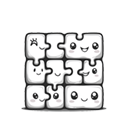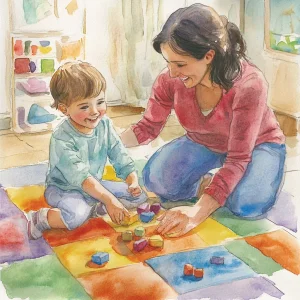Activity
Similar Activities
Sensory Texture Hunt for Developing Skills
Children’s Age: 4–7 years
Activity Duration: 5 – 10 minutes
Let's go on a Sensory Treasure Hunt! We will explore different textures like smooth stones, soft feathers, and rough sandpaper. You can use blindfolds for an extra challenge if you…
Activity Duration: 5 – 10 minutes
Healthy Harvest: Clay Creations - Making Healthy Food Sculptures
Children’s Age: 4–6 years
Activity Duration: 10 – 15 minutes
Engage children in the "Clay Creations - Making Healthy Food Sculptures" activity to boost their adaptive skills, self-care abilities, and academic progress through crafting nutrit…
Activity Duration: 10 – 15 minutes
Colorful Sorting Fun: Exploring Colors and Shapes
Children’s Age: 1.5–2 years
Activity Duration: 5 – 10 minutes
"Colorful Sorting Fun" is an engaging activity designed for children aged 18 to 24 months to boost their fine motor skills, cognitive abilities, and color recognition. Prepare colo…
Activity Duration: 5 – 10 minutes
Enchanted Nature Hunt: Sensory Exploration Adventure
Children’s Age: 1.5–2 years
Activity Duration: 5 minutes
The Sensory Nature Hunt activity is tailored for children aged 18 to 24 months, offering an engaging outdoor sensory experience. Through exploring nature using touch, sight, and so…
Activity Duration: 5 minutes
Enchanted Discovery: Sensory Treasure Basket Exploration
Children’s Age: 3 – 9 months
Activity Duration: 10 minutes
Explore the Sensory Treasure Basket activity for infants aged 3 to 9 months to support their sensory and cognitive development. Set up a safe exploration space with textured items …
Activity Duration: 10 minutes
Enchanted Musical Story Time Adventure
Children’s Age: 2–2.5 years
Activity Duration: 5 – 15 minutes
Join our "Musical Story Time Adventure" for children aged 24 to 30 months! This interactive activity boosts cognitive skills, cultural awareness, and language abilities through spo…
Activity Duration: 5 – 15 minutes
World Wonders: Around the World Ball Game
Children’s Age: 2–2.5 years
Activity Duration: 5 – 10 minutes
Explore the world with the "Around the World Ball Game," perfect for children aged 24 to 30 months. This fun activity enhances gross motor skills and cultural awareness by passing …
Activity Duration: 5 – 10 minutes
Adventure Tales: Family Sports Day Storytime Journeys
Children’s Age: 2–3 years
Activity Duration: 10 – 15 minutes
"Family Sports Day Storytime" is a storytelling activity tailored for children aged 24 to 36 months, focusing on language development, communication skills, and family togetherness…
Activity Duration: 10 – 15 minutes
Nature Shapes Adventure: Bird Watch & Scavenger Hunt
Children’s Age: 4–5 years
Activity Duration: 10 minutes
An outdoor activity for children aged 4-5 years combining bird watching and shape recognition.
Activity Duration: 10 minutes
Colorful Objects Sorting Game for Cognitive Development
Children’s Age: 1.5–4 years
Activity Duration: 10 – 15 minutes
This colorful sorting game is designed to boost your child's cognitive skills and nurture their curiosity. Gather safe, colorful objects like blocks or toys from your home. Place t…
Activity Duration: 10 – 15 minutes
Eco-Friendly Math Adventure: Crafting Math Tools & Challenges
Children’s Age: 6–7 years
Activity Duration: 30 minutes
Embark on the 'Eco-Friendly Math Adventure' for a blend of learning and eco-awareness! Gather recycled materials like cardboard, markers, and glue. Guide kids to create eco-friendl…
Activity Duration: 30 minutes
Magical Snack Time Adventure: Counting and Sorting Fun with Snack Time
Children’s Age: 3–5 years
Activity Duration: 5 – 20 minutes
"Counting and Sorting Fun with Snack Time" is a hands-on activity tailored for children aged 36 to 60 months to boost self-regulation and self-care skills. With small snacks, sorti…
Activity Duration: 5 – 20 minutes


























